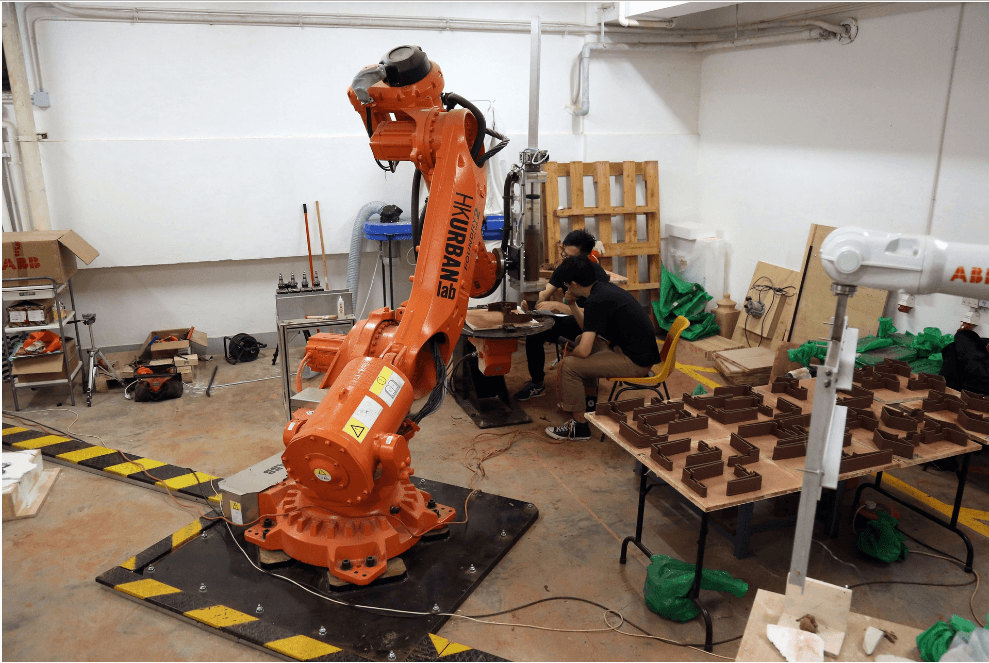






 Bricks, typically, are pretty uniform. Some of them may be a bit smaller or larger, but overall they tend to be the same rectangular shape. That’s not the case with the bricks in a recently built pavilion in Hong Kong. This pavilion, named the Ceramic Constellation Pavilion, is made up of about 2,000 bricks, each one a different shape and size. The effect is quite marvelous – a twisting, rippling tower with areas that vary in their solidity.
Bricks, typically, are pretty uniform. Some of them may be a bit smaller or larger, but overall they tend to be the same rectangular shape. That’s not the case with the bricks in a recently built pavilion in Hong Kong. This pavilion, named the Ceramic Constellation Pavilion, is made up of about 2,000 bricks, each one a different shape and size. The effect is quite marvelous – a twisting, rippling tower with areas that vary in their solidity.
The pavilion was built by the Faculty of Architecture at the University of Hong Kong (HKU) and funded by Sino Group, one of Hong Kong’s leading property companies. It was engineered by Goman Ho and Alfred Fong of Ove Arup and Partners Hong Kong Ltd. The Ceramic Constellation Pavilion was built in the first workshop of what’s being called the Sino Group Robotic Architecture Series, and it brings together new technology with an old material, clay, which has a long tradition of use in Hong Kong.
Each of the bricks was 3D printed from terracotta clay in a process that took about three weeks; each individual brick took only two to three minutes to print. They were then fired at a temperature of 1025ºC. The pavilion structure, which has a wooden base, was then assembled by architecture students in a 10-day workshop. The 3.8-meter-tall pavilion is load-bearing as well as being decorative, and each one of its faces shows different levels of opacity and transparency.
About 700 kg of clay was used to fabricate the structure, and the 3D printing was carried out in the new Robotics Lab at the HKU Faculty of Architecture.
“In a context that has been largely shaped by standardization and mass production, the project seeks to overcome the constraints of today’s architectural production through the introduction of a structure made entirely of non-standard components,” state the architects in the project description.
The project is only the first in the collaboration between the HKU Faculty of Architecture and Sino Group; the partnership will be an ongoing one aimed at examining new technology in architecture.
“The research initiative that supports arts, cultures, and technology is intended to foster cultural awareness of new technologies for the built environment,” the architects explain.
The Ceramic Constellation Pavilion is one more example of how 3D printing can create unique architectural structures. Several other pavilions have been created using 3D printing, each drastically different from anything else. A lightweight 3D printed biopolymer pavilion arched over Milan earlier this year, and a massive 3D printed bamboo pavilion was featured at last year’s Design Miami/ event. Beijing unveiled a beautiful, record-setting 3D printed pavilion inspired by silkworms, and a year later a Guinness World Record was snatched by the geometric 3D printed Rise Pavilion.
The HKU architects describe the Ceramic Constellation Pavilion as “one of the first of its kind in the world that incorporates this specific material system,” and that’s the beauty of these examples of architectural 3D printing. Each of these pavilions produced with 3D printing is unlike anything that has ever been built before, and demonstrates how 3D printing is capable of taking architecture from uniformity to uniqueness.
The Ceramic Constellation Pavilion was on exhibit for part of the summer and will soon be moved to the campus of HKU.
Prepared on the basis of 3D print.com